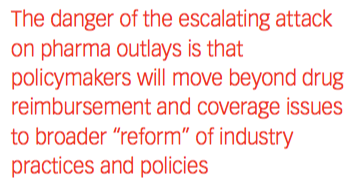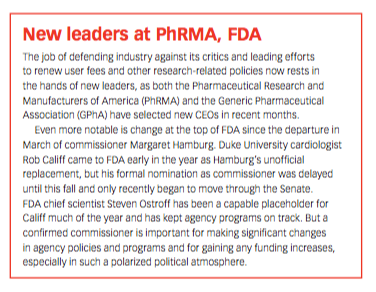Pharma Caught in Political Crosshairs
Pharmaceutical Executive
Drug pricing backlash threatens regulatory reform, R&D advances
It has become open season on pharmaceutical companies, as Congressional committees ramp up industry oversight and political candidates on all sides look to win points by attacking
Jill Wechsler

drug pricing and marketing. A sign of the times is that Republican presidential hopefuls have joined the fray, not willing to concede the field to Hillary Clinton and Bernie Sanders.
Sen. Marco Rubio of Florida and former Florida governor Jeb Bush cite the need to control drug costs as part of their proposals to repeal and revise Obama’s Affordable Care Act. One long-standing GOP theme is to lower drug prices through FDA “reform” that speeds more new drugs to market and, thus, promotes competition. Republican candidates still stop short of urging direct government intervention in the market and acknowledge that biopharma innovation saves lives, but now they’re blasting price hikes by industry “bad actors” and urging more transparency in product pricing.
In addition, the Republican leadership in Congress is jumping on the bandwagon. In the Senate, Special Committee on Aging chair Susan Collins (R-ME) has joined with Democrats in investigating drug pricing practices, starting with a December hearing focusing on Valeant and Turing Pharmaceuticals and two other firms. The House Judiciary Committee recently held a hearing on the role of pharmacy benefit managers (PBMs) in ensuring access to affordable medicines, and the House Oversight & Government Reform panel has announced hearings on drug prices early next year.
Although Republican drug-pricing complaints may remain muted during the GOP primaries, they will heat up in next year’s presidential campaign, as Democrats continue to ramp up the rhetoric against pharma price gouging. House Democrats have formed a special task force to press for “meaningful action” against skyrocketing drug costs. And the Obama administration weighed in with a public forum last month on the impact of drug price hikes and breakthrough therapies on healthcare spending and how utilization management and value-based purchasing strategies may affect patient access to affordable therapies.
Broader impacts
The danger of the escalating attack on pharma outlays is that policymakers will move beyond drug reimbursement and coverage issues to broader “reform” of industry practices and policies. One bi-partisan proposal in

Congress, for example, seeks to expand the scope of the Open Payments program to require pharma reports on payments to a wider range of health professionals. The Trans-Pacific Partnership agreement (TPP) and other trade pacts also may lose support among those who consider the trade deals overly protective of pharma intellectual property rights at home and abroad.
Enforcement officials are examining more closely competitive factors related to industry marketing and distribution practices, as seen in the recent disclosure of a Justice Department probe of pricing strategies on products marketed by Eli Lilly and by Merck. Industry mergers and acquisitions already face added scrutiny related to potential impact on product pricing, along with the implications of tax inversion deals.
Widespread anger over the spreading opioid abuse and overdose epidemic, which is killing thousands, has prompted state and local government lawsuits against manufacturers for over-promoting the painkillers. Patient advocates and cancer groups insist on the importance of ready access to necessary pain treatments, but health authorities blame industry marketing for encouraging excessive prescribing and dispensing.
'Cures' slow-down
One effect of the anti-pharma campaign is to delay action on the 21st Century Cures legislation, as questions emerge about the value of developing new medicines that may be too costly for many individuals to access. That has slowed efforts in the Senate to craft a companion “Cures” bill and dimmed prospects for provisions in the legislation that provide added incentives for drug research and testing.
At the same time, FDA may become more entangled in access and competition issues than it likes. Its oversight of pharmacy compounding, for one thing, may involve it in determining the basis for a large-scale compounder to produce a competitor to Turing’s costly antiparasitic treatment.
These developments overshadow important biomedical research advances and threaten to undermine the accelerated development and approval of important new therapies, particularly specialty treatments for rare diseases that often carry steep price tags. FDA approved 41 new drugs and 10 biologics in 2014, and this pace has continued in recent months, largely due to regulatory flexibility and expedited review programs.
The agency’s Patient-Focused Drug Development (PFDD) initiative is considered a great success in encouraging more risk-based consideration of new treatments for serious conditions. Yet there’s mounting criticism that some breakthroughs come to

market with insufficient safety information, and that patient advocates are overly influenced by industry funds.
The promise of greater access to less costly biotech therapies has generated widespread enthusiasm for developing new biosimilar therapies, and an important milestone this past year was FDA approval of the first product in this category, Zarxio from Sandoz. But additional biosimilars have been slow to reach the market, raising questions about whether FDA is being overly conservative in requiring data to document comparability of biosimilars to reference products, and if innovator companies have too much influence over key FDA policies for biosimilar labeling and naming.
Biopharma companies also played an important role in developing new vaccines and treatments to combat the Ebola virus, working with public health and research organizations to accelerate product formulation, clinical testing, and manufacturing systems. Despite the value of the industry’s role in providing treatments for lethal diseases around the world, companies continue to face criticism about medicines being unaffordable in poor countries.
Many of these issues stand to re-emerge next year as FDA and industry negotiate the next version of the Prescription Drug User Fee Act (PDUFA VI), which has to be reauthorized in 2017 to keep industry payments flowing to support FDA oversight of drugs and biologics, as well as fees for medical devices, generic drugs, and biosimilars.
All stakeholders look to continue programs for integrating patient perspectives into drug development and regulatory decision-making, while also examining strategies to ensure the long-term stability of the fee programs, to make funding more predictable for FDA, and to enhance investment in FDA information technology and the agency’s workforce. But hopes for quickly enacting a “clean” user fee reauthorization bill have faded as the political rhetoric heats up.
Jill Wechsler is Pharmaceutical Executive's Washington correspondent. She can be reached at jwechsler@advanstar.com

Addressing Disparities in Psoriasis Trials: Takeda's Strategies for Inclusivity in Clinical Research
April 14th 2025LaShell Robinson, Head of Global Feasibility and Trial Equity at Takeda, speaks about the company's strategies to engage patients in underrepresented populations in its phase III psoriasis trials.
Pfizer, GSK Gain ACIP Recommendations for RSV and Meningococcal Vaccines
April 18th 2025The Centers for Disease Control and Prevention’s Advisory Committee on Immunization Practices voted to expand access to Pfizer’s respiratory syncytial virus vaccine Abrysvo for high-risk adults in their 50s and voted in favor of GSK’s meningococcal vaccine, Penmenvy, for streamlined adolescent protection.
Study: GLP-1, SGLT2s Linked to Reduced Alzheimer Disease Risk in Patients with Type 2 Diabetes
April 17th 2025A new study found that patients with type 2 diabetes treated with GLP-1 receptor agonists and sodium-glucose cotransporter-2 inhibitors demonstrated lower risks of developing Alzheimer disease compared to other glucose-lowering drugs.
New Insights Into T Cell Exhaustion and Inflammation in Long COVID
April 17th 2025Nigel McCracken, chief operating officer, Virax Biolabs, discusses new findings that reveal altered cytokine activity and evidence of T cell exhaustion in long COVID patients, providing deeper insight into post-infection immune disruption.